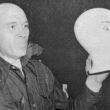Jeff Hutchins
I used to discount the statements of anyone claiming to have hit anything with a bullet at 1,000 yards.
Many were claiming the ability but few actually possessed it.
I would hear stories frequently of someone shooting a deer, elk, antelope etc. at 800, 900, 1,000 yards and beyond. Usually a couple of carefully asked questions would let me know whether there was even the possibility of the claimant actually having sufficient knowledge of all things long range to pull off such a shot.
How fast is your bullet going? Have you actually chronographed that bullet or are you just extrapolating from the loading data? How much does your bullet drop at 500, 600, 650, 700, 725, 850 and 1,000 yards? What’s the ballistic coeffecient of the bullet? How much was the wind blowing and in which direction?
Shooters capable of making these shots can answer these questions rather rapidly. The ones that can’t, well … can’t. The number of shooters who possess that capability now has grown exponentially in the last 10 years. But many of these shooters still rely too much on myth and legend, or poor advice from friends, or the interweb. So let’s dispel a few of those myths.
There is NO, I repeat NO magic caliber. I mean that by bullet diameter. The atmosphere doesn’t care whether your bullet measures .001 inch across or .999 inch – the ballistic coefficient (BC) is everything. A long skinny bullet is more aerodynamic than a short fat one. No rocket science here … well, maybe a little bit.
A 22/250 shooting a bullet with a .350 BC at 3,500 feet per second has exactly the same exterior ballistic arc as a 30-06 shooting a .350 BC at 3,500 feet per second. Obviously, long bullets generally equal heavy bullets, so the two go hand-in-hand. That heavier bullet maintains its velocity better as well, just because of inertia.
So the simple solution is just to shoot the heaviest bullet you can find in your cartridge of choice. This is exactly contrary to what most shooters used to believe (and some still do) – that light bullets shoot flatter because of the higher velocity.
Both thoughts are partially right and partially wrong. Every cartridge has what I call an “efficiency threshold” (ET). The .308 Winchester is most efficient with bullets in the 165-168 grain range, the 30-06 Springfield is 180s, .300 Winchester Magnum 180-200, .300 Weatherby Magnum 200, .300 Remington Ultra magnum 220-230.
The factor at play is basically case capacity of the cartridge. If you put a 180-grain bullet in a .308, it doesn’t come out of the end of the barrel and fall on its face or bounce off of elk at 300 yards. But you have exceeded the ET. The 308 simply can’t push a 180-grain bullet at a high enough velocity to use it efficiently.
The 30-06 has just enough more capacity to add the velocity necessary to efficiently use that heavier bullet. It’s a matter of diminishing returns. You have to spend time looking at ballistic charts, bullet velocities and comparing various weights’ performance at long range.
In no way do heavier bullets always equal better ballistics or higher energy; you can always go too heavy and topple the ET. If you go too light, the down range energy is sacrificed and you have not reached the ET.
However, for all of this to work, you have to compare apples to apples. In some cases, this is hard to do as cartridges operate at different chamber pressures and the loading manuals have to reflect that.
The .270 Winchester vs. .280 Remington is a perfect example. The .280 was brought out by Remington specifically for use by their semi-automatic Model 740 rifle. Because of this, the chamber pressure was set lower for it. As a result, factory ammo rarely achieves the velocity that the smaller .270 does.
The loading manual will show a similar result. In a modern bolt- action rifle, the .280 can safely be loaded to the same pressure levels of the .270 and the performance will jump up past it.
Here is the reason for that: All other factors being equal, a larger bore diameter cartridge will produce higher velocities.
There are two reasons for this. One, the volume of the barrel is higher giving the powder more space to burn inside of the barrel before the bullet exits. The larger bullet base also gives the powder gases more surface area to work against, pushing the bullet harder down the barrel.
A perfect example of this is the 30-06 compared to the 35 Whelen. Fairly comparing apples to apples, the hottest 30-06 loads produce about 3,300 foot pounds of energy. The Whelen, which is simply a 30-06 nocked up .050 of an inch in diameter, can go up around 3,600 foot pounds. The extra energy is a direct result of the increased caliber; it’s as simple as that.
In my experience the 7 mm fans think there is something magic about that caliber. The 7 mm Remington Magnum fans claim it outperforms the 300 Winchester Magnum. (totally impossible). The 7mm/08 fans claim it outdoes the 308 (it shoots a little flatter) and the 7mm Utra Mag. will leave a 300 Ultra in its dust ( ah… NO).
I often ask how they figure this is the case. The answer is always that they can put a 180-grain Burger VLD in their 7mm and the BC is much higher than the BC of the .30 caliber 180-grain projectile.
Well, duh! If I take a 180-grain bullet and squeeze it down to 6.5mm, it will have a much higher BC than the 7mm, so what? I will shoot a 210-grain bullet in the .30 caliber, it will match your 7mm’s BC, and I get all of the advantages of the larger bore we discussed above. The heavier bullet will retain its velocity better and the bullet will hit with more authority at the target.
It must be human nature to put what you prefer on a pedestal and look for the lesser version of something else to compare it to. It might make you feel better about your choice but you are really just fooling yourself.
The .30 caliber is not magic either, if you move up to the 300 Ultra necked up to .338 (.338 Edge) it will beat the 300 Ultra if you feed it 300-grain bullets with a high BC.
So, you have to decide how much recoil you want to put up with. If your recoil tolerance is low, 260 Remington or 6.5 Creedmoor is an excellent choice. If you can take a bit more, I would grab a .280 Ackley Improved. If a magnum is not out of the question but the excellent 300 Win. Mag. kicks just a little more than you like, choose the proven 7mm Rem. Mag. or the old 264 Win. Mag.
Remember one thing, however: Large animals require large amounts of power to put down cleanly. Don’t discount retained energy at long ranges and realize when you are so far out that just hitting the animal is not all that’s involved. If you are shooting inanimate objects, then the ballistic arc is all that matters.
Excellent shooting will make up for lacking ballistics every time.
Knowing your limitations on what you’re comfortable with as far as recoil and rifle weight will put you far ahead of Mr. Macho.
I am not recoil sensitive (yet) and shoot my rifle very well, but a deer is a lot safer from me at 800 yards with my 300 Ultra Mag. than from a Marine sniper and his much less ballistically favorable 308/7.62.
I might hit it; he almost definitely will hit it. Practice makes perfect.
I used to be a huge detractor of the hunting shows on TV showing 1,000 yard-plus shots every episode, because they give the impression that if you just buy one of their rifles with one of their scopes on it, harvesting game at extreme ranges is just a credit card away – just point and kill.
I still hold that against them, but the inspiration that created a ton of capable long-range shooters was a happy byproduct.
Jeff Hutchins writes occasionally about firearms-related topics for The New Era. He operates Rangemaster Gunworks at 1144 Tangent St. in Lebanon.




